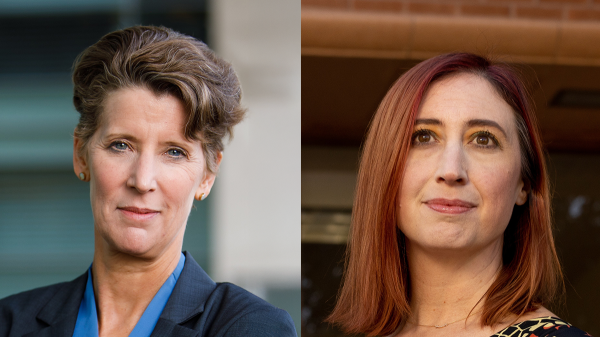ASU students learn the ways of science policy-making through immersive summer session

Ira Bennett (far right, front row) and the nanotechnology group representing one of this summer's Science Outside the Lab sessions at ASU's Washington, D.C. Center.
Science Outside the Lab (SOtL) is an experiential education program designed to teach participants about the relationships between science, policy and societal outcomes in a place where decisions about these important issues are often made — Washington, DC.
The program was developed in 2002 by Dan Sarewitz, co-director of ASU’s Washington, D.C.-based think-tank, the Center for Science, Policy and Outcomes, and Neal Woodbury, director of ASU’s School of Molecular Sciences.
Beginning with just one session funded by an Integrative Graduate Education and Research Traineeship grant from the National Science Foundation, the program has continued to grow steadily, administering five sessions in the summer of 2017 attended by more than sixty students from fifteen universities.
Ira Bennett, associate director for research at ASU’s School for the Future of Innovation in Society, was a doctoral student in chemistry in 2002 when he participated in SOtL’s inaugural summer session. In 2007, Bennett and Jameson Wetmore, associate professor with the School for the Future of Innovation in Society, became co-directors of the program. SOtL remained grant funded until it switched to a fee-based model in 2010, at which point it began to grow year after year to what it is today.
“We realized there was a demand for it,” Bennett said. “Two degree programs from ASU (the Master of Science and Technology Policy program and the Solar Energy Engineering & Commercialization program) recognized the value and made SOtL a degree requirement. That really bolstered growth.”
Now managed by ASU’s Center for Engagement and Training in Science and Society, a multi-disciplinary research center within the Institute for the Future of Innovation in Society, SOtL stays true to its think-tank roots by focusing largely on science policy, while helping participants understand the roles that science plays in shaping society.
SOtL offers one or two-week sessions for both graduate and undergraduate students. Each course in the program presents a range of immersive activities including museum visits, tours of the nation’s capital, and behind-the-scenes views of federal agencies. Students have an opportunity to listen to and question the people actually involved in creating science policy that affects the entire nation, specifically professionals with a broad view of their organization’s operations.
Using ASU’s Washington Center as its headquarters, SOtL shows participants the inner-workings of Washington, DC, the source of much of the country’s national science policy, and over $140 billion in federal science funding.
By leveraging the strong network it has fostered over the years, SOtL’s directors are able to design each session based on the interests and needs of its participants. Students from the solar energy program meet with professionals in the solar industry as well as government employees with energy portfolios. Participants in a session paid for by a nanotechnology grant will have their agendas similarly tailored.
SOtL participants learn the nuances of science communication from Slate magazine’s Torie Bosch, editor of Future Tense. Senior members of the Environmental Protection Agency, the Food and Drug Administration, and the National Academy of Sciences provide valuable insight into how science is funded, regulated, critiqued and studied.
By presenting participants with as many viewpoints as possible, SOtL encourages participants to challenge their assumptions and think critically about institutions. One of Bennett’s favorite activities is a visit with Briana Pobiner, research scientist and museum educator with the Human Origins Program at the Smithsonian National Museum of Natural History.
Pobiner’s stories reveal unexpected complexities that are typical of her world.
For instance, a donor might require that the exhibit bear their name for twenty years, forcing Pobiner to think about how to design exhibits that will remain relevant for two decades. In another example, Pobiner had prepared her staff for creationist protests at the installation of a new human origins exhibit, yet protestors arrived representing Greenpeace, incensed not over the content of the exhibit, but rather over the identity of its donor.
“Most of what people learn about science we learn outside of school,” Bennett said. “Museums are one of the places where people are continuing to learn about science and, for that matter, their federal investments.”
Meeting congressional staffers, lobbyists, funding agency officers, regulators, journalists, academics, museum curators, and more introduces SOtL participants to career paths they may never have considered before. The effect these conversations and presentations can have on students is life changing.
“In the professions, as in academia and life in general, there’s so much we take at face value,” Bennett said. “What we try to do with SOtL is push our students to think about the negotiations, the tradeoffs, the personalities — the political action — inherent in many of those experiences.”
Written by Adam Gabriele
More University news

2 ASU faculty members elected to prestigious National Academy of Medicine
Two distinguished Arizona State University faculty members have been elected to the National Academy of Medicine.Sally C.…

ASU establishes Center for Free Speech, will host annual free speech forum
Arizona State University is establishing a new Center for Free Speech to encourage the uninhibited exchange of ideas, and the…

Public affairs professor, back at ASU after 3 years with NSF, is named Sackton Chair
After three years at the National Science Foundation, Professor Mary Feeney has returned to Arizona State University, where she…